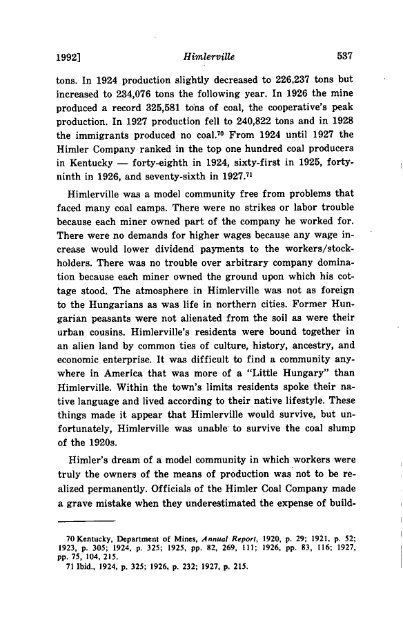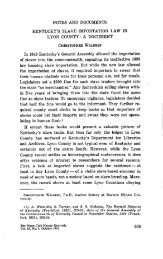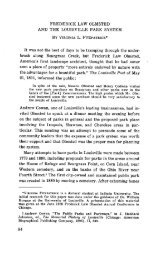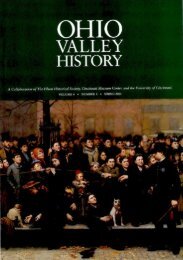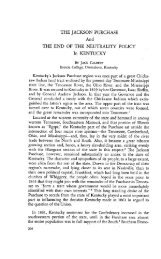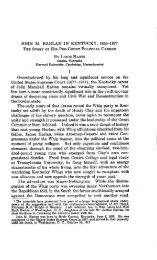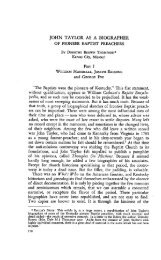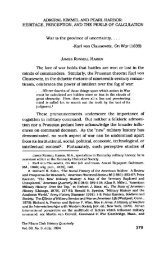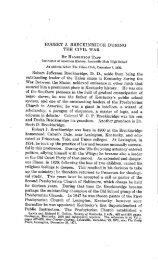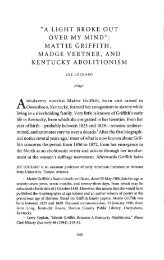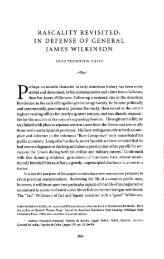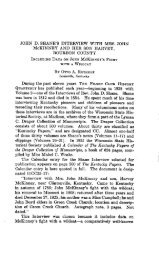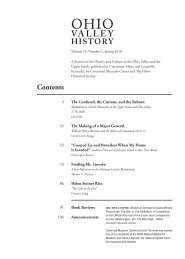Himlerville: Hungarian Cooperative Mining in Kentucky - The Filson ...
Himlerville: Hungarian Cooperative Mining in Kentucky - The Filson ...
Himlerville: Hungarian Cooperative Mining in Kentucky - The Filson ...
You also want an ePaper? Increase the reach of your titles
YUMPU automatically turns print PDFs into web optimized ePapers that Google loves.
1992] HimlerviUe 537<br />
tons. In 1924 production slightly decreased to 226,237 tons but<br />
<strong>in</strong>creased to 234,076 tons the follow<strong>in</strong>g year. In 1926 the m<strong>in</strong>e<br />
produced a record 325,581 tons of coal, the cooperative's peak<br />
production. In 1927 production fell to 240,822 tons and <strong>in</strong> 1928<br />
the immigrants produced no coal.T° From 1924 until 1927 the<br />
Himler Company ranked <strong>in</strong> the top one hundred coal producers<br />
<strong>in</strong> <strong>Kentucky</strong> -- forty-eighth <strong>in</strong> 1924, sixty-first <strong>in</strong> 1925, fortyn<strong>in</strong>th<br />
<strong>in</strong> 1926, and seventy-sixth <strong>in</strong> 192731<br />
<strong>Himlerville</strong> was a model community free from problems that<br />
faced many c0al camps. <strong>The</strong>re were no strikes or labor trouble<br />
because each m<strong>in</strong>er owned part of the company he worked for.<br />
<strong>The</strong>re were no demands for higher wages because any wage <strong>in</strong>crease<br />
would lower dividend payments to the workers/stock-<br />
holders. <strong>The</strong>re was no trouble over arbitrary company dom<strong>in</strong>ation<br />
because each m<strong>in</strong>er owned the ground upon which his cot-<br />
tage stood. <strong>The</strong> atmosphere <strong>in</strong> <strong>Himlerville</strong> was not as foreign<br />
to the <strong>Hungarian</strong>s as was life <strong>in</strong> northern cities. Former <strong>Hungarian</strong><br />
peasants were not alienated from the soil as were their<br />
urban cous<strong>in</strong>s. <strong>Himlerville</strong>'s residents were bound together <strong>in</strong><br />
an alien land by common ties of culture, history, ancestry, and<br />
economic enterprise. It was difficult to f<strong>in</strong>d a community anywhere<br />
<strong>in</strong> America that was more of a "Little Hungary" than<br />
<strong>Himlerville</strong>. With<strong>in</strong> the town's limits residents spoke their na-<br />
tive language and lived accord<strong>in</strong>g to their native lifestyle. <strong>The</strong>se<br />
th<strong>in</strong>gs made it appear that <strong>Himlerville</strong> would survive, but unfortunately,<br />
<strong>Himlerville</strong> was unable to survive the coal slump<br />
of the 1920s.<br />
Himler's dream of a model community <strong>in</strong> which workers were<br />
truly the owners of the means of production was not to be re-<br />
alized permanently. Officials of the Himler Coal Company made<br />
a grave mistake when they underestimated the expense of build-<br />
70<strong>Kentucky</strong>, Department of M<strong>in</strong>es, Annual Report, 1920, p. 29; 1921. p. 52;<br />
1923, p. 305; 1924, p. 325; 1925, pp. 82, 269. II1; 1926, pp. 83. 116; 1927,<br />
pp. 75, 104. 215.<br />
71 Ibid., 1924, p. 325; 1926, p. 232; 1927, p. 215.


